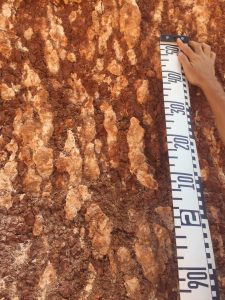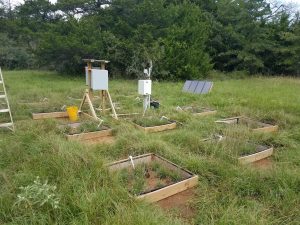How and when do calcium carbonates accumulate in soils?
| Soil carbonates provide records of changes in arid-subhumid environments that date back hundreds of millions of years. Because soil carbonates form close to the surface of the Earth, there is an enormous variability in the environmental conditions they might record. For instance, the soil temperature during summer can be 10 or even 15°C higher than the temperature during spring. Which do soil carbonates record? It is not just temperature that varies seasonal, but soil CO2 concentrations, the relative respiration rates of different types of plants, the source and isotopic composition of rainfall all vary. In order to accurately interpret soil carbonate records, we need to understand how and when (e.g., what time of year, only during certain years?) carbonates accumulate in soils. Our efforts here involve theory, experiments and observations of natural soils.
Former student Nate Meyer simulated soil carbonate accumulation using UNSATCHEM. You can read about his study in the published version of his M.S. thesis. |
|
| In collaboration with Dr. Tim Gallagher, we are monitoring soil carbonate dissolution and precipitation by measuring simultaneously and nearly continuously the CO2 and O2 concentration of soil pore space gas. Respiration consumes O2 and produces CO2 in nearly equal proportions. The precipitation/dissolution of calcium carbonates affects CO2 only. Thus departures from the respiration trend after accounting for diffusion and for exchange between gas and water tell us about calcite dissolution and precipitation. This monitoring is being carried out in outdoor experimental soils at the Stengl Lost Pines Biological Station (photo to left). |



